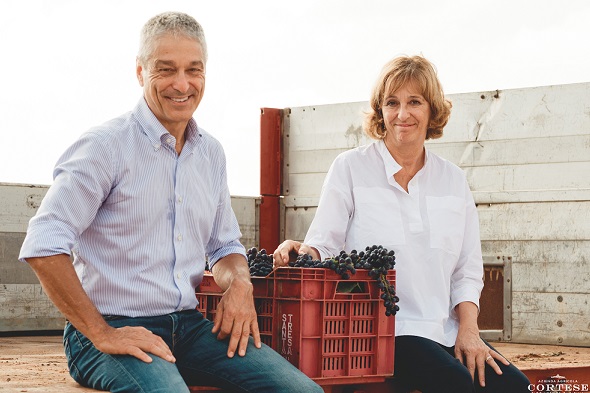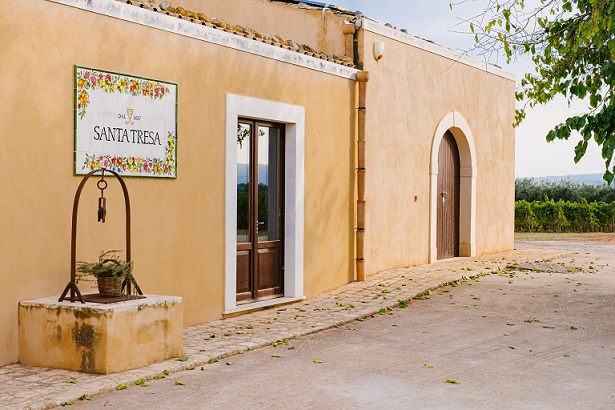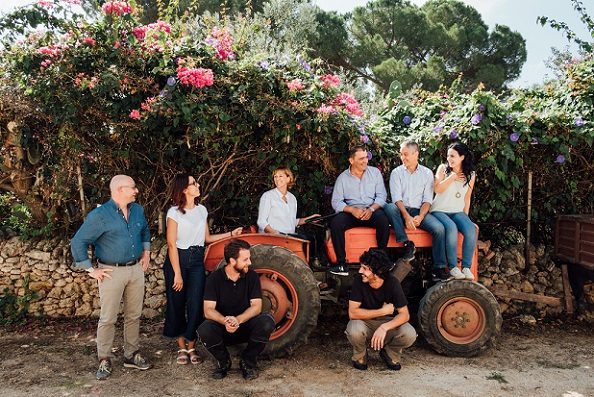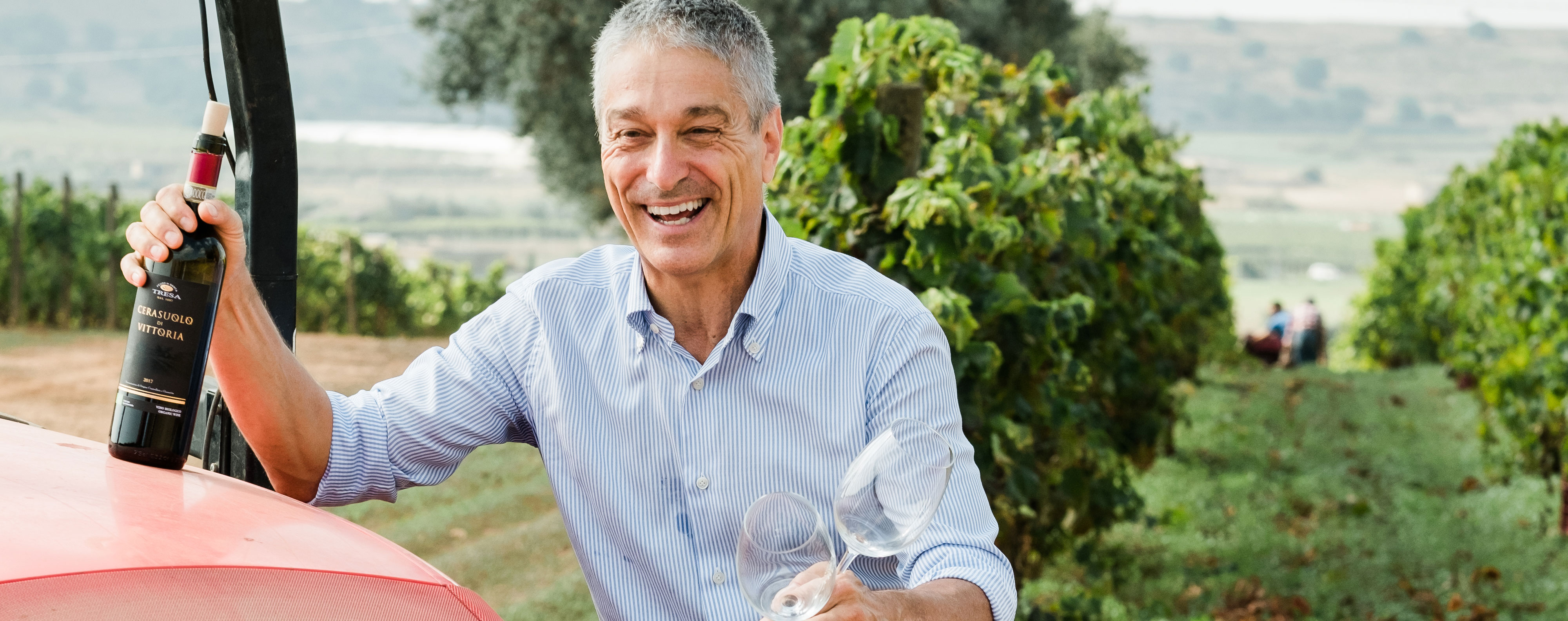“We use oak wisely,” he states, as we taste two whites and two reds via Zoom.
Half the wines are from the Santa Tresa estate, which Stefano and Marina (below) bought in 2001, and the other two are from Azienda Agricola Cortese, acquired in 2016.

The two estates are only 8km away from each other but offer very different styles of wine. Both are farmed organically with biodiversity, sustainable practices and indigenous grape varieties at their core. But each wine also offers a lesson in using oak in different ways to benefit the wine.
“I really want my wine to use the oak to enhance the wine, not to cover it up with different flavours,” Stefano says.

The first wine is from Santa Tresa, which has been certified organic since 2009.
Rina Ianca is a 70-30 blend of Grillo and Viognier which, according to Stefano, “balances the weakness of one grape variety and enhances the two varieties” – with the Viognier adding malic acid and freshness.
Santa Tresa has been producing this blend for 20 years and has had “tremendous success” with it, Stefano says. In the beginning, he admits, they made mistakes “like putting this wine in barrique” but now they have settled on the following protocol for both varieties, even though the Grillo is picked three weeks after the Viognier.
- Handpicking into 15kg crates.
- Refrigerated for 12 hours to drop the grapes’ temperature from 29°C to 6°C (so they don’t have to worry about the temperature of the must).
- Destemmed and crushed.
- Macerated for four to six hours.
- Softly pressed.
- Fermented at 17-18°C.
- Blended.
- Kept on fine lees until bottling the following May or June.

“We have learnt one thing over the years – we don’t bottle the white wine too early,” Stefano says. “White wines coming from Sicily do need time to really develop and mature. If you bottle them too early you really do not show the character of the wine.”
The Azienda Agricola Cortese white, Vanedda (above), is a blend of Cataratto and Grillo with a splash of Fiano.
“We had a lot of fun with this wine,” Stefano says. “It’s a beautiful combination.”
The grapes are co-fermented on skins for a couple of days in a 30hl Slavonian oak barrel – one of three found in the cellar when they bought the Cortese property.
“We wanted to follow a little bit of tradition, and what we realised is that by fermenting the wine in this 30hl barrel we managed to get a really complex wine. At the same time, what we do is we leave the wine on fine lees until the end of the summer.”
'That’s what I think the market wants'While sipping the gold-coloured wine, with its complex honey nose, broad palate, and lashings of acidity and minerality, Stefano adds: “We’re really proud to bring back some tradition to vinification without doing anything radical and at the same time really coming up with a wine that speaks Sicily in a different way – because that’s the whole idea. I believe that Sicily has incredible potential to show differences and that’s what I think the market wants. We need wines with a point of difference.”

Moving on to the distinctive reds from Sicily’s only DOCG, Cerasuolo di Vittoria…
The Santa Tresa Cerasuolo di Vittoria 2018 (above) is a blend of 60% Nero d’Avola and 40% Frappato. The interesting thing about this wine is that 15% of the Nero d’Avola is dried on the vine to intensify the flavours.
With Nero d’Avola providing the structure and Frappato the perky red fruits, Stefano describes it as “a mix of fruit and spices. It’s very intense”.
Although the grapes are picked at different times, they undergo the same vinification: chilled, destemmed, and then fermented in 40hl barrels.
“The whole idea was to reintroduce an old technique,” Stefano explains. “The use of oak at fermentation is a really important process because it does help the polymerisation of the tannins as quickly as possible. But we don’t want the oak to be excessive and flavour the wine.”
After frequent remontage and délestage, the wines are blended and put in old casks for a year.
Cortese’s Sabuci Cerasuolo di Vittoria 2018 is made with the same percentages of Nero D’Avola and Frappato, but the vinification is very different. The Nero D’Avola is fermented in open-top barriques while the Frappato goes into unlined amphora.
“The amphora is a philosophy by itself,” Stefano offers. “It’s a very porous material and the wine gets oxidised by itself so, in 2017 (the second year of experimentation with amphorae), we left the wine on skins for one year.
“By having the skins and the pips – they’re very important – you have the tannins to contrast the oxygen, and you get a totally different dimension to the wine.”
'You get a totally different dimension to the wine'But it requires regular checks to see what’s happening in the 700L amphora.
Fermenting the Nero d’Avola in open-top barriques is “a phenomenal experience”, according to Stefano. “It’s an old way we have rediscovered.”
The barriques take about 180-190kg of grapes – which are punched down by hand.
Stefano has been using this technique for five vintages and, he says, every vintage has been different. “You get an incredible colour and incredible structure.”
Typically, the Nero d’Avola will stay in the barrique until the wine goes through MLF, but it depends on the vintage.
After MLF, this wine goes into a 3,000L botti. Once the Frappato comes out of amphora, it is blended with the Nero d’Avola and put in three- to four-year-old barriques, or the botti.
“We try very hard to keep the personality of the wine,” Stefano states. “They are all like small babies and have very different personalities. We try to keep this personality untouched because our duty is to try to preserve what we get in the vineyard and not to change it. So, by doing this and reintroducing old winemaking techniques, we try to enhance the style of the wines more than change it.”
All the wines are bottled with less than 100mg/L total SO2 “because using healthy grapes and because of the protocols we follow, we don’t need so much”. However, the sacrifice is the complexity that could come from native yeasts.
When Stefano joined the Zoom call, he was fresh from tasting two wines that had fermented with native yeasts but, generally – for the moment – he uses cultivated yeasts “to be sure that there is no problem with the vinification, because sometimes when you use wild yeasts you can end up with 5g/L of residual sugar”.
They are, however, experimenting with a wine with no sulphur added and are learning from it. The aim is eventually to move towards native ferments. “You expose yourself to a lot of potential risk but there is a typicity that is even more than what we’re doing today,” he reflects.

What other winemakers say about oak
‘Respect in the vineyard, courage in the winery.’ That’s the motto driving Italian wine producer Stefano Girelli’s new project in Sicily. Our 2018 interview with him.













.png)






